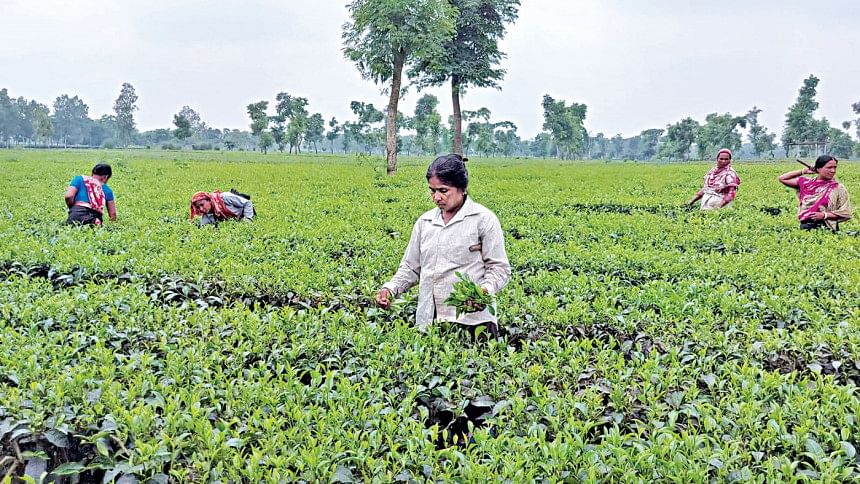Northern districts, the dark horse of local tea industry

Most of the land in Rangpur's Panchagarh and Thakurgaon districts, particularly those that border India, were non-arable just a few decades ago, when the region closely resembled a desert of sand and stone.
Besides, the job scarcity in northern districts meant that local low-income groups faced many hardships.
Considering the situation, Prime Minister Sheikh Hasina visited the region in 1996, the same year she assumed office, to speak with the then Deputy Commissioner of Panchagarh, Rabiul Islam, about the prospect of tea cultivation.
After hearing his opinion, the prime minister asked Islam to begin cultivating tea on an experimental basis.
At first, Islam planted the tea in pots before transplanting them onto a piece of land.
Hasina also asked her principal secretary to immediately instruct the tea board's chairman at the time to conduct a feasibility study on tea cultivation in the country's northern regions.
Inspired by the success of the experimental phase, she then asked the authorities concerned to redouble their efforts.
As such, the tea board formed a three-member committee on October 13, 1999, to complete the feasibility study.
After visiting different upazilas of Panchagarh and Thakurgaon, the survey team compiled a report where they mentioned that the two districts collectively had about 40,000 acres of land that were suitable for tea cultivation.
Seeing potential in the industry, several members of Tea Professional Welfare Society decided to set up a small-scale tea plantation in Panchagarh under the banner of Tentulia Tea Company.
Brig Gen Daniel Islam, chairman of Bangladesh Tea Board at the time, formally inaugurated the company's compound on April 2, 2000, the same year that Kazi and Kazi Tea Estate began commercial production on a large scale in the same district.
In 2001, a sub-centre of Bangladesh Tea Research Institute was set up in Panchagarh.
The board went on to take numerous other initiatives to expand cultivation in the region, including discussion meetings, providing training, distributing saplings, and arranging loans from Rajshahi Krishi Unnayan Bank at low interest rates.
It also provided irrigation sets for small growers under a "Development of Small Holding Tea Cultivation in Northern Bangladesh" project.
With this support and other motivations, tea cultivation enjoyed great success in the northern districts with farmers constantly becoming more interested to involve themselves in the industry.
Since then, the tea cultivation has created employment opportunities for about 25,000 people, a large number of whom are women, in Panchagarh and Thakurgaon.
Many of those who had very little to eat in the two districts are now self-reliant thanks to the industry. As such, Panchagarh and Thakurgaon have helped Rangpur emerge as the third largest tea producing division in the country after Chattogram and Sylhet.
Across five northern districts -- Panchagarh, Thakurgaon, Lalmonirhat, Dinajpur and Nilphamari -- there are about 50,000 acres of land suitable for tea cultivation, of which 10,170 acres are being used for that purpose this season.
Tea plantation has expanded to 8,642 acres in Panchagarh, 1,293 acres in Thakurgaon, 112.96 acres in Lalmonirhat, 71.09 acres in Nilphamari, and 61.50 acres in Dinajpur.
Cultivation in the northern parts of Bangladesh grew at an average of 15 per cent per annum over the past five years.
Apart from 26 large gardens in the region, there are 7,310 small farmers who produce tea on their own.
Large gardens and small growers in the five districts aim to produce 12 million kilogrammes (kg) of tea worth Tk 180 crore in the current season.
In 2020, tea was cultivated on 8,060 acres of land in the districts with a target to produce 9.5 million kgs.
Even despite the ongoing coronavirus pandemic, last year's target was exceeded as 18 factories produced 10.3 million kgs of tea from 50.12 million kgs of raw leaves.
The northern region accounted for about 12 per cent of the national tea production in 2020.
"As the land in the northern districts are more fertile compared to Chattogram and Sylhet, growers can pluck leaves after a year of planting saplings," said Mohammad Shamim Al Mamun, senior scientific officer of the Bangladesh Tea Board's office in Panchagarh.
During a visit to different areas in the district, this correspondent spoke with several small growers on how they become self-reliant through tea cultivation.
Ishag Ali Mandal, one of the few growers in Tetulia upazila of Panchagarh who planted tea in the industry's early days, said he cultivated tea on 30 acres of land this season, up from 2.5 acres in 2000.
On average, he earns Tk 50 lakh per year from his tea garden.
Similarly, Abul Hossain, of Pediagach village in the same upazila, cultivated tea on 20 acres this season.
According to the farmer, the land was left unutilised before tea cultivation began in the region.
"But now, small growers who cultivated tea on their own land have become solvent," he said.
Several tea growers mentioned that they suffer losses when processing factory owners stop purchasing green tea leaves during the peak of plucking season.
However, Asma Jahan, Monira Begum and several others who were seen plucking tea leaves from a field in Shalbahan of Tetulia upazila said they work at the garden year-round and are not concerned about having to find other jobs.
Amirul Haque Khokon, president of Bangladesh Small Tea Growers Association, told this correspondent that the tea sector was flourishing in the northern region, especially in Panchagarh and Thakurgaon.
"The industry will expand even faster if the government takes the initiative to set up a state-owned tea factory and third auction centre in Panchagarh to ensure fair prices," he said.
Khokon also urged the government to provide irrigation facilities, training and assistance for mechanisation.

 For all latest news, follow The Daily Star's Google News channel.
For all latest news, follow The Daily Star's Google News channel. 



Comments